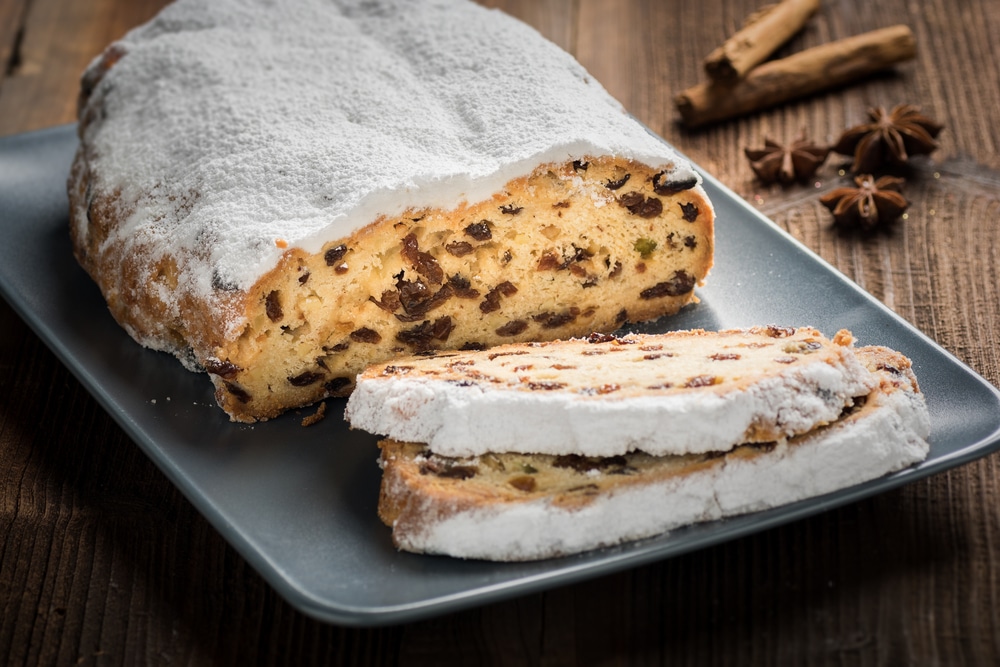Dresden, the capital of Saxony, is known for its cultural gems. Many people immediately think of the Frauenkirche, the Zwinger or the Semperoper. But just as symbolic is the Christmas stollen for Dresden. The fragrant yeast cake, enriched with raisins and butter, is a symbol of Dresden and famous far beyond the borders. But what is behind the Christmas pastries?
What makes the Dresden Christmas Stollen special and how is it made?
Stollen are bread-like yeast cakes, which are usually decorated with poppy seeds, almonds or dried fruit and are especially popular at Christmas time. The Dresden variant is known for its special recipe, which is based on old family recipes. Germany has applied for a European quality seal for the stollen, which confirms its origin in Dresden . Only pastries that meet the strict criteria and are produced in Dresden or the neighboring areas may bear the name “Original Dresdner Stollen” and receive the golden seal. The traditional Dresden recipe contains a rich yeast dough with butter, sultanas, almonds, orange peel, candied lemon peel and a secret spice mixture. The dough is then kneaded with a kneading machine or by hand and shaped into its typical elongated shape. The original Dresdner Christstollen is baked for about 60 minutes at 230°C at the beginning and later at 180°C when the temperature drops. Buttered by hand and refined with powdered sugar, it is packaged and stored properly.
A little journey through time: The history of the Christmas stollen
The history of the Dresden tunnel dates back to the 15th century. At that time, Dresden was part of the Holy Roman Empire and the Electorate of Saxony. During this time, stollen were consumed as a source of calories during Lent. In terms of taste, however, the Stollen was similar to bread at that time and was made without butter due to the butter ban. So this has not yet been a culinary highlight. Elector Ernst of Saxony wanted to improve the taste experience of the dish and from now on add butter to the stollen. In his butter letter, he turned to the Pope with the request to refrain from the butter ban. By adding butter, Elector Ernst of Saxony hoped for a more pleasant aroma of the pastry. In 1491, the Pope finally approved the butter in the Stollen and the butter ban was lifted.
From here begins the history of the now well-known Dresden Christmas Stollen and butter became one of the main ingredients in the famous Christmas biscuits. With the discovery of America, new spices were added to the original Stollen and have shaped its current taste ever since. But not only the culinary composition, but also the shape of the Christmas stollen has a historical, religious background: The Christmas stollen is intended to remind us of Jesus Christ and symbolize the born baby Jesus, wrapped in a cloth.
Follow in the footsteps of the Dresden Stollen at the Striezelmarkt

The first Christmas markets in Germany were established in the 15th century. The Dresden Striezelmarkt was one of the first of its kind. This was also the place where the Christmas stollen were sold for the first time. To this day, it is known for its variety of delicacies and regional specialties. But where does the name of the Striezelmarkt actually come from? This also has to do with the Dresden Christmas stollen. Because the Christmas stollen is also called Striezel.
A visit to the Striezelmarkt is definitely worthwhile for young and old. In addition to the smell of fresh spices and hot mulled wine, gourmets will also get their money’s worth on a walk through the Christmas market: waffles, langos, pastries, candied and chocolate-coated nuts or fruits, but of course also various stollen creations are offered extensively in the Christmas stalls. In addition to the original, traders such as Stollen from Dresden offer a variety of variations of the pastry. These can even be ordered online. Stollen variations such as almond, poppy seeds, marzipan or chocolate stollen are popular.


